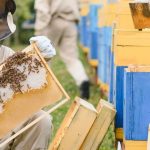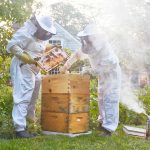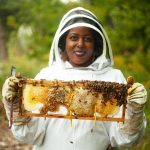Costs and Rewards of Beekeeping: Beekeeping, also known as apiculture, is a captivating venture that not only contributes to the environment but also offers sweet rewards. As you embark on this journey, it’s natural to wonder about the investment, effort, and potential returns. In this comprehensive guide, we’ll address key questions, including “How much is beekeeping?,” “How much work is beekeeping?,” “How much does it cost to start beekeeping?,” and “How much do beekeepers make an hour?” Let’s dive into the fascinating world of beekeeping economics.
1. How Much is Beekeeping: Investing in Nature’s Architects
Beekeeping, like any hobby or business, involves certain costs. The initial investment includes acquiring the necessary equipment, such as beehives, bee suits, smokers, and hive tools. Additionally, there are ongoing expenses related to bee feed, medications, and replacement of worn-out equipment.
Understanding the Initial Investment
Starting with the basics, a beginner beekeeper can expect to spend around $300 to $500 on essential equipment. This includes the cost of purchasing or building beehives, protective gear, and tools. The type of hive and its components, such as frames and foundations, can influence these costs.
Ongoing Expenses
Beekeeping is a year-round endeavor, and ongoing expenses should be considered. These may include the cost of bee feed, which becomes crucial during periods of low nectar flow or in preparation for winter. Additionally, budgeting for medications to prevent or treat bee diseases is essential for maintaining a healthy colony.
2. How Much Work is Beekeeping: Tending to the Hive
Beekeeping demands dedication and consistent effort. The level of involvement varies based on factors such as the number of hives, the season, and the specific goals of the beekeeper. Understanding the workload is crucial for those considering beekeeping as a hobby or a business.
Seasonal Workload
Beekeeping is a seasonal activity with distinct tasks for each part of the year. Spring and summer are typically busier as bees are most active. Tasks include hive inspections, honey extraction, and swarm prevention. Fall involves preparing the hive for winter, and winter itself requires monitoring and providing supplemental food.
Time Commitment
On average, beekeepers may spend several hours per week on hive inspections, maintenance, and other tasks. However, the time commitment can vary. Those with a few hives may find the workload manageable as a hobby, while commercial beekeepers with numerous colonies may dedicate significant time to their beekeeping business.
3. How Much Does it Cost to Start Beekeeping: Budgeting for Success
Starting a beekeeping venture involves more than just purchasing bees and a hive. It requires careful planning and budgeting to ensure a successful and sustainable endeavor.
Equipment Costs
As mentioned earlier, the initial investment in beekeeping equipment ranges from $300 to $500. This includes the cost of the hive, protective gear, and essential tools. However, beekeepers can choose to build their own hives to reduce costs.
Bee Purchase
The cost of purchasing bees varies based on factors such as the type of bees and the region. On average, a package of bees with a queen can range from $100 to $150. Alternatively, beekeepers may opt to buy nucleus colonies, which are more established and can cost between $150 and $200.
Training and Education
Investing in beekeeping education is crucial for success. Workshops, courses, and books can provide valuable insights and skills. While these may add to the initial costs, they contribute to a beekeeper’s knowledge and confidence.
4. How Much Do Beekeepers Make an Hour: Assessing Returns
Beyond the costs, prospective beekeepers often wonder about the potential returns and financial aspects of beekeeping. While beekeeping can be a rewarding hobby, it’s essential to set realistic expectations regarding income.
Honey Production and Sales
The primary source of income for many beekeepers is the sale of honey. The amount of honey produced depends on factors like hive health, weather conditions, and local flora. Beekeepers may sell honey locally, at farmers’ markets, or through online platforms.
Pollination Services
Commercial beekeepers may also earn income by providing pollination services to farmers. Bees play a crucial role in pollinating crops, and farmers often hire beekeepers to bring their colonies to pollinate orchards and fields.
Other Bee-Related Products
Beekeepers can diversify their income by selling other bee-related products, such as beeswax, pollen, propolis, and even beekeeping equipment. Exploring these avenues can contribute to a more robust and varied income stream.
Conclusion: Balancing Costs and Rewards in Beekeeping
In the captivating world of beekeeping, the journey involves not only an investment of money and time but also a commitment to the well-being of these essential pollinators. Understanding how much is involved in terms of both costs and work is key to embarking on a successful beekeeping venture. Whether you’re drawn to the environmental benefits, the joy of harvesting your honey, or the potential income, beekeeping offers a sweet symphony of challenges and rewards. π―π









